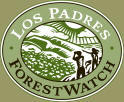|
MOUNTAIN LION
Puma
concolor
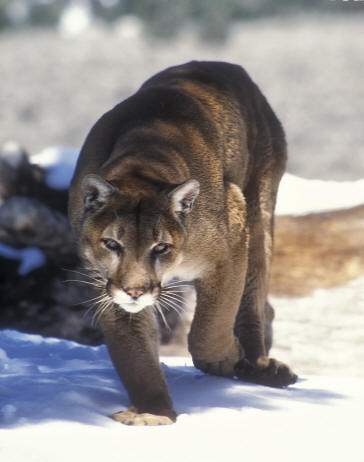
Mountain lion near Mt. Pinos on
the Los Padres NF
©
Dan Blackburn
Mountain lions (also
called cougars or pumas) are solitary animals found throughout the
state of California. About half of the state is suitable lion
habitat (shown
in red in the map below) and they can generally be
found wherever deer, their primary prey, are found. Mountain
lions roam across nearly all parts of the Los Padres National
Forest and portions of the Carrizo Plain National Monument, but
their exact numbers are unknown.
PHYSICAL
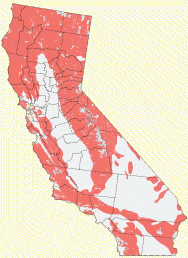 Mountain
lions are slender and agile cats. Adults usually stand a little
over 2 feet tall at the shoulders, and can be between 5 and 9
feet long from nose to tail. They have large paws and
proportionally the largest hind legs in the cat family; a
physique that allows it great leaping ability - a reported 18
feet vertical! Coloring is plain, typically tawny, with lighter
patches on the under body including the jaws, chin, and throat.
Like domestic cats, they vocalize in low-pitched hisses, growls,
and purrs. Mountain lions are obligate carnivores, meaning they feed
only on meat. Mountain
lions are slender and agile cats. Adults usually stand a little
over 2 feet tall at the shoulders, and can be between 5 and 9
feet long from nose to tail. They have large paws and
proportionally the largest hind legs in the cat family; a
physique that allows it great leaping ability - a reported 18
feet vertical! Coloring is plain, typically tawny, with lighter
patches on the under body including the jaws, chin, and throat.
Like domestic cats, they vocalize in low-pitched hisses, growls,
and purrs. Mountain lions are obligate carnivores, meaning they feed
only on meat.
LIFE CYCLE
Female mountain lions average
one litter (typically two to three cubs) every two to three
years throughout their reproductive life. Parenting is a
mom-only responsibility; female mountain lions are known to be
fiercely protective of their cubs, and have been seen to
successfully fight off animals as large as grizzly bears in
their defense. Born blind, cubs are completely dependent on
their mother and begin to be weaned at around three months of
age. As they grow, they start field trips from the den, first
visiting kill sites, and after six months beginning to hunt
small prey on their own. Young adults leave their mother to
attempt to establish their own territory at around two years of
age and sometimes earlier; males tend to leave sooner. Life
expectancy in the wild averages 8 to 10 years.
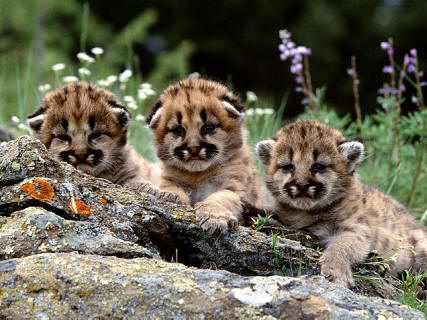
Mountain lion cubs.
Mountain lions require large
blocks of intact habitat to survive. The average home range of a
mountain lion varies from 36 square miles for adult females, to
more than 140 square miles for adult males.
LIONS ON THE LOS PADRES NATIONAL
FOREST
During a drought cycle in the
mid-1970s, the Los Padres National Forest was documented to have
one of the highest densities of mountain lions reported within
the state. The mountain lion is a Management Indicator Species
(MIS) for the Los Padres National Forest. MIS are species whose
population or habitat trends are believed to indicate the
effects of management activities and to serve as a focus for
monitoring. The mountain lion is one of 12 MIS for
the Los Padres, serving as a bellwether for the effects of
habitat fragmentation (other MIS include the bigcone
Douglas-fir, California spotted owl, arroyo toad, and valley
oak).
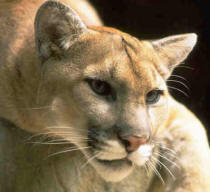 The
statewide population is estimated at 6,000 lions, but the number
of lions in the Los Padres National Forest is unknown. But the
Los Padres does have vast tracts of unfragmented wilderness habitat
that are ideal for supporting mountain lion populations. No
surveys have been conducted either state-wide or regionally, so
scientists use indicators (such as depredation,
attacks on people, and predation on prey populations) to
estimate lion densities. Based on this data, the California
Department of Fish and Game estimates that lion populations in
the state peaked in 1996, then
decreased somewhat, and have remained stable for the past
several years. The
statewide population is estimated at 6,000 lions, but the number
of lions in the Los Padres National Forest is unknown. But the
Los Padres does have vast tracts of unfragmented wilderness habitat
that are ideal for supporting mountain lion populations. No
surveys have been conducted either state-wide or regionally, so
scientists use indicators (such as depredation,
attacks on people, and predation on prey populations) to
estimate lion densities. Based on this data, the California
Department of Fish and Game estimates that lion populations in
the state peaked in 1996, then
decreased somewhat, and have remained stable for the past
several years.
In our region, researchers with
the National Park Service are currently tracking mountain lions in the Santa
Monica Mountains and adjacent mountain ranges to determine
movements and landscape connectivity. The Forest Service and
California Department of Fish and Game are conducting a study in
the San Gabriel Mountains to look into the bighorn sheep decline
and relation to mountain lion predation. Also, scientists from
the U.S. Geological Survey are planning to radio-collar
additional mountain lions in the San Gabriel Mountains in
support of both these projects.
THREATS
With the passage of the
California Wildlife Protection Act in 1990, mountain lions became
a Specially Protected Mammal, a formal classification that prohibits the killing of
mountain lions in the state. The California Department
of Fish and Game can issue depredation permits that allow a
lion to be killed if it attacks livestock or pets. Statewide,
148 mountain lions were killed via depredation permits in 2000,
a number that has steadily declined since then -- 48 lions were
killed via depredation permits in 2009. Mountain lions can also
be killed if they become a public safety threat, but thankfully
there have been less than twenty verified mountain lion attacks
on humans in all of California since 1890.
Mountain Lion
Depredation, 2005-2009
source: California
Department of Fish & Game
|
County |
Permits Issued |
Lions Killed |
|
Ventura |
11 |
5 |
| Santa
Barbara |
17 |
9 |
| San
Luis Obispo |
27 |
13 |
|
Monterey |
24 |
10 |
| Kern |
15 |
10 |
The biggest threat to the
mountain lion in southern and central California is the
isolation and fragmentation of large blocks of suitable habitat
by freeways, highways and development. Maintenance and
restoration of corridors between large areas of wildlands is
essential to conserving populations in southern California, and
thus the habitat found in the backcountry of the Los Padres is
incredibly important in providing for the long-term viability of
this species.
The massive fires on the forest
in recent years also play an interesting role in mountain lion
ecology. Large-scale wildland fires allow for vegetation
conditions which may be preferred by deer, increasing the prey
base for a period of time. However, wildfires also remove
vegetation that serves as hiding
cover for lions, making hunting conditions more difficult.
In chaparral environments, mountain lions
are attracted to the edges of burns where deer tended to
congregate, but still it is unknown if fire actually benefits
or harms mountain lion populations overall.
FORESTWATCH: PROTECTING
MOUNTAIN LIONS
ForestWatch is working to
protect large tracts of habitat in the Los Padres National
Forest that are essential for mountain lion survival. We are
also working with the Forest Service to ensure that it and
partner agencies, including the California Department of Fish
and Game, adequately survey for mountain lion populations on the
Los Padres National Forest. Long-term population data is
critical to determine whether mountain lions are being harmed by
land management activities and habitat fragmentation. ForestWatch also monitors the issuance of depredation permits to
ensure that mountain lions are not needlessly killed.
|
